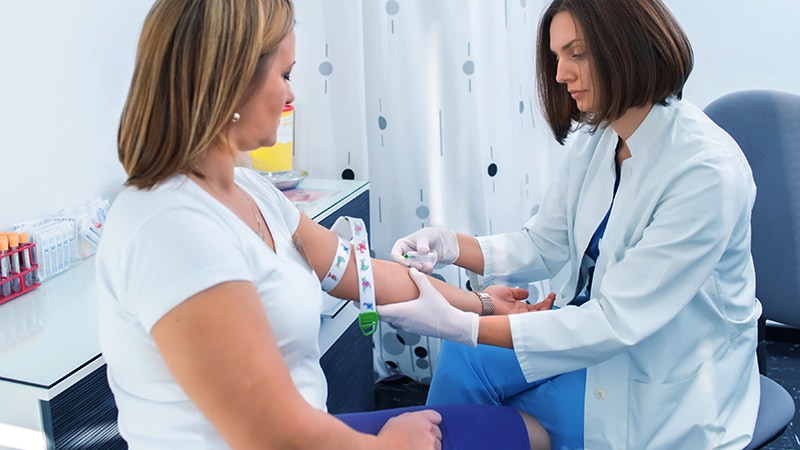Switching therapy based on early biomarker results increased progression free survival (PFS) in patients with hormone receptor (HR)-positive, human epidermal growth factor receptor 2 (HER2)-negative metastatic breast cancer, according to new findings presented at the San Antonio Breast Cancer Symposium (SABCS).
Researchers found that median PFS doubled for patients who changed therapy from an aromatase inhibitor plus palbociclib to fulvestrant plus palbociclib when rising ESR1 mutations were detected prior to disease progression.
At a median follow-up of 26 months, the median PFS for patients who switched to the selective estrogen receptor degrader (SERD) was 11.9 months compared with 5.7 months in the group that stayed on the aromatase inhibitor.
“The PADA-1 trial is the first clinical trial to demonstrate the clinical utility of ESR1 mutation monitoring,” said lead author François-Clément Bidard, MD, PhD, a professor of medical oncology at Institut Curie and Paris-Saclay University in Paris, France, who presented the findings at SABCS. “The trial suggests a statistically and clinically significant benefit when fulvestrant is used.” Plus, “no new safety signals” emerged, he added.
ESR1 mutations are known to confer resistance to endocrine therapy in the metastatic breast cancer setting. These mutations herald a poor prognosis, so their clearance early in the treatment course may greatly reduce the risk of recurrence.
“These mutations drive resistance of ER-positive metastatic breast cancer to aromatase inhibitors but retain sensitivity of ER-alpha degradation by SERDs,” Bidard said. “ESR1 mutation monitoring in the blood allows for optimizing the endocrine therapy partner of CDK4/6 inhibitor [palbociclib] in the first line.”
Bidard also pointed out that blood ESR1 mutations are rare at diagnosis, occurring in less than 5% of patients, but become more frequent — occurring in up to 40% of patients — at progression under first-line aromatase inhibitor-based treatment. And these mutations “are predictive of resistance to aromatase inhibitors but not to fulvestrant or palbociclib,” he said.
In the three-step PADA-1 trial, Bidard and colleagues evaluated the clinical benefit associated with a switch to fulvestrant-palbociclib after detecting a rising ESR1 mutation in the blood.
In step 1, a total of 1017 patients with metastatic HR-positive disease who received an aromatase inhibitor plus palbociclib had blood samples analyzed for ESR1 mutations every 2 months. Within this group, a mutation was detected in 279 patients prior to (219 patients) or concurrent with (60 patients) disease progression, and 407 experienced disease progression in the absence of an ESR1 mutation.
In step 2, those with a mutation detected who did not experience concurrent disease progression were randomly assigned to continue their current treatment regimen (84 patients) or to switch to fulvestrant plus palbociclib (88 patients).
Step 3 consisted of an optional crossover to fulvestrant-palbociclib following disease progression for patients randomly assigned to the standard treatment arm.
The two co-primary study endpoints were PFS in the second step and global safety.
Bidard and colleagues found that the median PFS was 5.7 months in the aromatase inhibitor-palbociclib arm and 11.9 months in the fulvestrant-palbociclib arm (hazard ratio, 0.63; P = .007).
A total of 70 patients subsequently developed disease progression in the aromatase-palbociclib arm, and 47 were included in the optional crossover cohort. At a median follow-up of 14.7 months, the median PFS observed in the crossover cohort was 3.5 months.
“We believe that the[se] results justify the implementation of the PADA-1 treatment strategy as a valid option,” said Bidard. “At a higher level, we believe that monitoring the rise of resistance-associated mutations opens up new opportunities” for using new agents such SERDs in metastatic breast cancer.
But unanswered questions regarding these results remain.
In a discussion of the paper, Minetta Liu, MD, a professor of oncology at the Mayo Clinic College of Medicine and Science, Rochester, Minnesota, commented that “these findings support serial ctDNA monitoring as a means to identify and react to treatment resistance as soon as possible.” However, she added, “whether this strategy translates into a meaningful survival benefit remains to be demonstrated.”
Liu added that it is critical to understand that a rising ESR1 mutation doesn’t indicate a quantitatively increasing number; rather, it indicates the detection of the ESR1 mutation, which is “a distinction [that needs] to [be] made clear as we review this data,” she said.
Liu also noted that benefits of switching therapies early “must be balanced by quality of life and resources related to oral vs intramuscular drug administration.”
“The potential to avoid disease-related symptoms with an earlier change in therapy needs to be explored,” she noted. “Patient-reported outcomes were collected but no results are reported.”
This study was funded by Pfizer. Bidard holds a patent for the ESR1 ddPCR assay used in this study; receives consulting fees from AstraZeneca, Eli Lilly and Company, Novartis, Pfizer, Radius Health, Roche Pharmaceuticals, and Sanofi; receives fees for other services from Pfizer and Seagen; and performs contracted research for Pfizer, ProLynx Inc, and Seagen. Liu disclosed relationships with Roche/Genentech, Pfizer, and many other companies.
San Antonio Breast Cancer Symposium (SABCS) 2021: Abstract GS3-05. Presented December 9, 2021.
For more from Medscape Oncology, join us on Twitter and Facebook.

